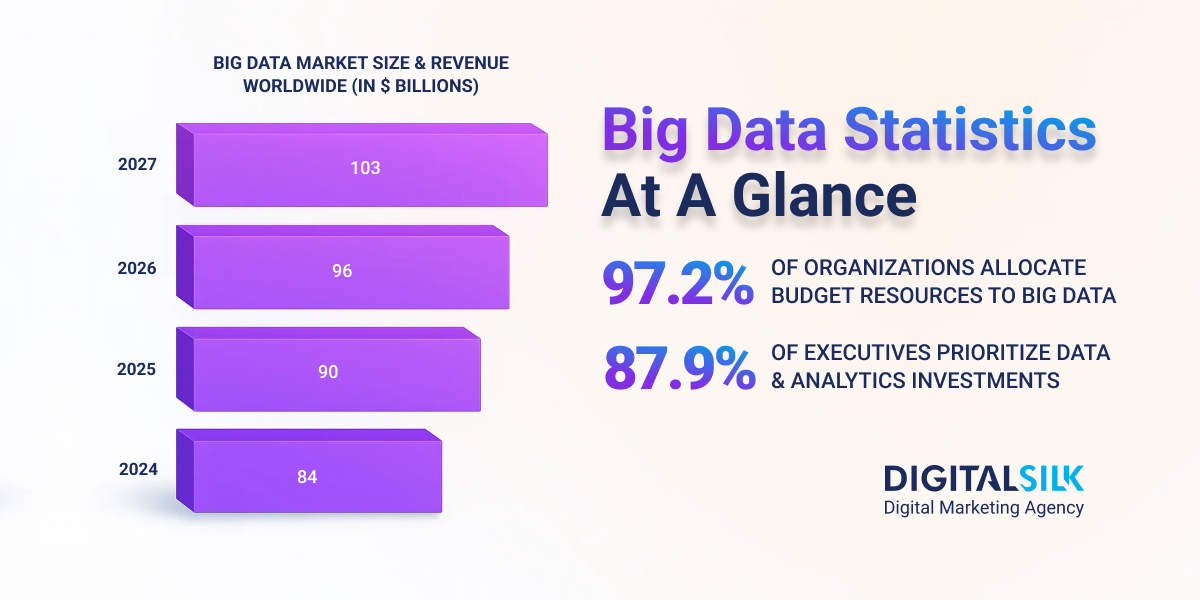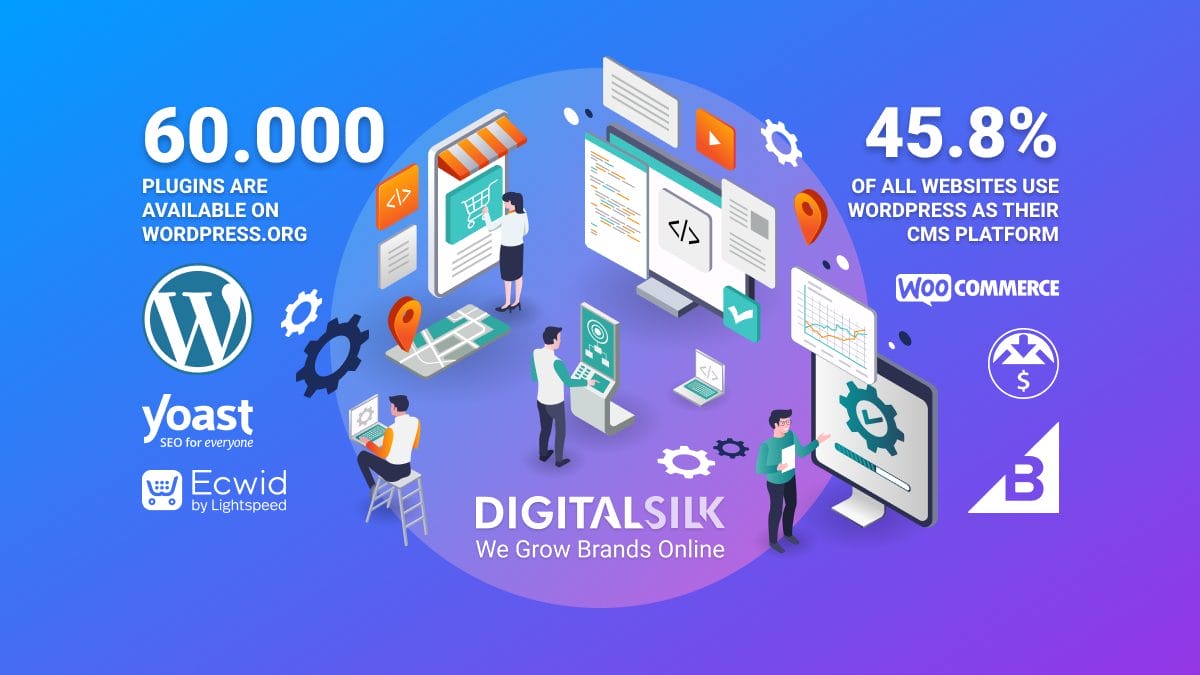Big Data Statistics: Key Highlights
-
Worldwide data volume is expected to hit 394 zettabytes by 2028.
-
97.2% of companies are allocating part of their budgets for big data.
-
A lack of analytics expertise affects 77% of businesses trying to harness their data.
Companies are generating data at a pace that’s surpassing their ability to unify it, ensure its accuracy and turn it into strategic direction.
The gap between raw information and meaningful action keeps widening as organizations grapple with scattered sources, inconsistent quality and mounting volumes.
That pressure is fueling massive investment, with the global big data market projected to reach $103 billion by 2027 as companies race to build the infrastructure and capabilities to keep up.
In this post, we’ll explore 35 big data statistics that highlight the strategies driving growth, the hurdles slowing progress and the trends shaping how companies turn data into advantage.
General Big Data Facts And Statistics
Big data is transforming how organizations plan, operate and compete, with growing ties to emerging web development trends.
As data volumes surge, companies are investing heavily in analytics to improve decision-making and boost return on investment across digital initiatives.
The big data and statistics below highlight the market’s rapid growth, where investments are concentrated and how rising demand is reshaping the future workforce.
- The global big data analytics market is expected to be valued at $961.89 billion by 2032, growing at a 13.5% CAGR.
- The U.S. big data industry is expected to reach a value of $248.89 billion by 2032, underscoring its role as a key driver of global growth.
- By 2028, the total volume of data created, captured, copied and consumed worldwide is expected to reach 394 zettabytes.
- By 2028, big data in business intelligence applications is projected to reach $63.5 billion, making it the largest segment compared to data integration tools, enterprise performance analytics and supply chain management.
- Big data specialists are projected to be the fastest-growing job role from 2025 to 2030.
- 87% of employers see AI and big data skills increasing in importance in that same time frame.
What These Numbers Mean For You
- Prioritize enterprise-wide data strategies. Establish a unified roadmap that aligns big data initiatives with long-term business goals and allocates resources for scalable infrastructure.
- Link analytics to ROI metrics. Define clear performance indicators that connect analytics outcomes to revenue growth, operational efficiency and digital innovation.
- Accelerate workforce development. Launch upskilling programs and partnerships to build a steady pipeline of big data specialists and analytics talent.
Implementation And Adoption Statistics For Big Data
How much is big data reshaping the way organizations operate?
Adoption is accelerating as companies build strategies, allocate budgets and expand teams to support data-driven initiatives.
The big data fun facts below show how widespread this shift has become, where adoption is most concentrated and the measurable impact it is beginning to deliver.
- 97.2% of organizations allocate budget resources to big data.
- User-generated content makes up 70% of the world’s data.
- 87.9% of executives rank investments in data and analytics as a top organizational priority.
- Big data and analytics is the second most widely adopted technology worldwide, with 61% of organizations using it on either a small or large scale.
- Among industries, the highest projected AI and big data adoption from 2025 to 2030 is in automotive and aerospace and telecommunications at 100%.
- Just 23.9% of organizations consider themselves data-driven, while only 20.6% report having a strong data culture.
- Businesses investing in data and analytics see a 20% boost in profitability or performance.
What These Numbers Mean For You
- Capitalize on user-generated content. Develop frameworks and policies to capture, clean and analyze user-generated data at scale to uncover real-time market signals.
- Focus on high-adoption industries for faster returns. The facts about big data reveal opportunities in sectors like automotive, aerospace and telecommunications where adoption is accelerating fastest.
- Capitalize on user-generated content. Develop frameworks and policies to capture, clean and analyze user-generated data at scale to uncover real-time market signals.
Fun Facts About Data Processing And Storage
The systems that process and store data are the backbone of modern business, shaping how insights are created and delivered.
Investments in platforms, infrastructure and cloud services continue to climb as organizations seek faster analytics and greater scalability.
The interesting statistical data below highlights the technologies leading their markets, the scale of global infrastructure growth and the shifting priorities driving this expansion
- In 2025, Apache Kafka holds the largest share of the big data processing technologies market worldwide at 18.13%.
- MATLAB holds an 18.23% share of the global advanced analytics and data science technologies market in 2025.
- Mode holds the largest share of the global Business Intelligence (BI) software market in 2024 at 21.12%.
- In 2024, Google Global Site Tag leads the web analytics technologies market worldwide with a 34.49% share.
- Pinterest Analytics tops the global marketing analytics technologies market in 2024 with 50.17%.
- Linkfluence accounts for 56.32% of the global social media analytics and monitoring software market in 2024.
- The United States operates 5,426 data centers in 2025, the most of any country worldwide.
- The U.S. data center market is expected to generate $212.06 billion in revenue in 2029.
- Public cloud environments contain 49% of the world’s stored data in 2025.
- Enterprise spending on cloud infrastructure services hit $330 billion in 2024.
- In 2025, worldwide public cloud services end-user spending is expected to reach $824.76 billion, growing at a 22.1% CAGR.
- 74% of companies use data warehouses as their main public cloud service.
- 66% of advanced cloud businesses believe a single pane of glass, which consolidates all monitoring and management into one interface, is vital to controlling costs and gaining visibility across their cloud infrastructure and big data systems.
- The hybrid cloud market is valued at $172.77 billion in 2025 and is projected to grow to $311.75 billion by 2030, with a CAGR of 12.53%.
What These Numbers Mean For You
- Invest in infrastructure to handle the massive amount of data. Plan for scalable cloud, hybrid and data center capacity to support future storage and processing demands.
- Align cloud spending with strategic outcomes. Track cloud service investments against operational KPIs to ensure rising costs translate into measurable business gains.
- Integrate a single pane of glass for visibility. Implement unified dashboards that centralize monitoring and cost control across all data systems and cloud environments.
Big Data Stats On Key Challenges
Organizations are collecting more data than ever, yet many struggle to translate it into meaningful outcomes.
Skills gaps, funding limits and data quality issues are slowing progress and reducing the value companies can extract from their data.
These obstacles affect every area of operations, from product strategy to data-driven marketing, where reliable insights are essential for lead generation and conversions.
The big data statistics below reveal the most pressing challenges holding organizations back.
- 77% of companies report a deficit of data analytics skills and talent in their workforce, which hinders their ability to get value from data.
- 27% of companies say their biggest challenge in handling and analyzing large data sets is managing the budget or total cost of analytics.
- 48% of businesses compromise on the complexity of their queries to manage big data analytics costs.
- While 76% of respondents say making data-driven decisions is a top goal, 67% admit they don’t fully trust the data their organization relies on.
- Data quality is cited as the biggest data integrity challenge by 64% of companies.
- For 54% of organizations, funding is a major obstacle to effective data programs.
- 62% of data and analytics leaders say that difficulty attracting and recruiting talent will pose a significant obstacle to achieving their goals.
What These Numbers Mean For You
- Establish dedicated analytics budgets. Treat data programs as strategic investments and secure multi-year funding to reduce cost-related disruptions.
- Prioritize data trust initiatives. Implement robust governance, data lineage tracking and validation processes to boost confidence in decision-making.
- Embed data quality ownership. Assign clear accountability for data standards within each business unit to reduce integrity issues and rework.
Why Big Data Processing Matters
When you consider how much data exists in the world and how quickly it multiplies, processing becomes the hinge between raw information and real business value.
The points below show how effective data processing translates massive volumes of information into practical advantages for businesses:
- Improved decision-making: Processing larger and more diverse data sets gives leaders a clearer view of patterns, reducing guesswork and strengthening the rationale behind major business moves.
- Faster operational problem-solving: Data processing highlights inefficiencies and hidden issues across departments, allowing teams to act on root causes instead of surface symptoms.
- Sharper personalization: With 90% of people seeking better use of their data for more relevant brand communication, big data processing enables personalization at scale by transforming customer signals into timely, meaningful engagement.
- More accurate forecasting: Sophisticated processing reveals trends early and refines predictive models, improving planning for everything from market demand to supply chain shifts.
- Broader strategic perspective: Combining data from across systems and functions creates a fuller picture of the business, surfacing connections that drive innovation and uncover untapped opportunities.
The Future Of Big Data Usage And Innovation
Big data is evolving from a background function into a core driver of growth, shaping how companies approach strategy, customer engagement and market expansion.
The predictions below build on fun data facts from current trends, showing how shifts in technology, talent and expectations are likely to redefine how organizations use data to compete.
- More connected business functions: Organizations are likely to unify data systems across departments so leaders can work from shared information and align finance, operations, marketing and product planning on common goals.
- Growing demand for specialized talent: Expanding data environments will probably increase the need for professionals who can build scalable systems, interpret analytics and translate findings into strategic direction.
- Wider adoption of real-time analytics: Organizations are likely to move toward systems that process and analyze data as it’s created, enabling faster adjustments during day-to-day operations.
- More advanced personalization: Combining behavioral, transactional, and contextual data will probably help companies shape experiences that build stronger engagement and improve loyalty.
- Closer alignment with business outcomes: Big data efforts are likely to be evaluated more on their contribution to revenue growth, operational efficiency and market share than on technical milestones alone.
Optimize Big Data Collection And Analysis With Digital Silk
Big data holds the potential to uncover opportunities hidden across disconnected systems and processes.
When approached with the right strategy, it turns fragmented information into focused insights that guide smarter decisions and measurable growth.
Digital Silk uses industry-leading technologies to build tailored data ecosystems that streamline collection, improve analysis and unlock insights that fuel long-term performance.
As a full-service digital agency, we offer:
Our team takes responsibility for the full project lifecycle, delivering clear communication and tangible results.
Contact our team, call us at (800) 206-9413 or fill in the Request a Quote form below to schedule a consultation.
"*" indicates required fields









